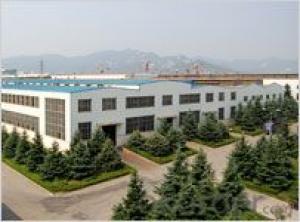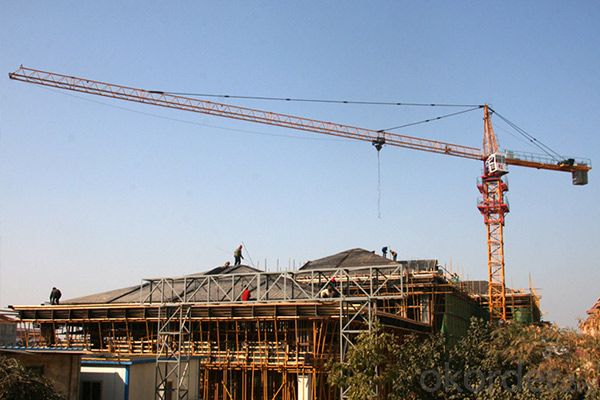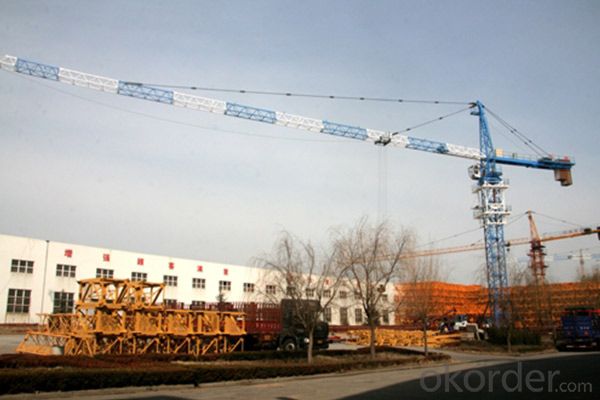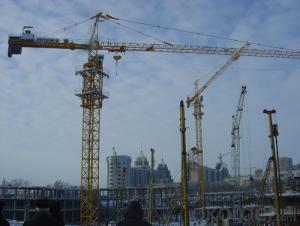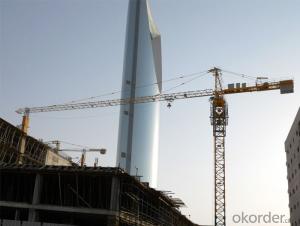TOWER CRANE QTZ31.5 lifting mechanism adopts speed regulation by frequency control
- Loading Port:
- Qingdao
- Payment Terms:
- TT or LC
- Min Order Qty:
- 1 unit
- Supply Capability:
- 6 unit/month
OKorder Service Pledge
OKorder Financial Service
You Might Also Like
The tower crane is a hydraulic tower crane with swing top, horizontal jib and mobile trolley. It has the hoisting moment for315Kn.m;the maximum hoisting load of 3t and the maximum working radius of 39m.The hoisting height of anchoring tower crane is 25m and that of climbing tower crane is 100m.
The tower crane has ingenious design, beautiful shape and simple structure .It is easy to operate and maintain, and is safe and at a reasonable price .It is an ideal construction machines for construction enterprises. It has hoisting mechanism, swing mechanism, top-rising mechanism and radius mechanism, which can work individually or cooperatively to make a high efficiency. The top-rising mechanism is used to raise or lower tower. The hoisting mechanism has 3-speed electronic motor respectively for high, medium and slow hoisting speeds. It has flexible swing mechanism and radius mechanism and slewing mechanism for vertical and /or horizontal transportation of building materials in one time.
The tower crane has complete and sensitive protection devices such as hoisting weight limiter, hoisting moment limiter, hoisting height limiter, radius limiter and swing limiter to ensure of regular operation. It also has rest platform, guardrail and other protection devices. Driver’s cab is at a side of rib and has big space and wide visual field.
The tower crane has excellent performance and is suitable for hoisting in short civil or industrial buildings or loading or unloading in ports or goods yards

1 Main technical Parameters
Name | Unit | Index | |
QTZ31.5 | |||
Nominal hoisting moment | kN.m | 315 | |
Max. hoisting weight | t | 3 | |
Rated hoisting weight at jib nose | t | 0.734 | |
Working radius | m | 2.5~39 | |
Height | Independent | m | 25 |
Attached | m | 100 | |
Hoisting Speed | Ratio. |
| 2 |
Hoisting speed | m/min | 42/21/7 | |
Swing speed | r/min | 0.45/0.7 | |
Radius speed | m/min | 33 | |
Top-hoisting speed | m/min | 0.7 | |
Weight(independent) | t | 19.5(21) | |
Ballast weight | t | 5 | |
Max. swing radii | m | 39.75 | |
rear swing radii | m | 10.37 | |
Max. working wind speed | m/s | 20 | |
Max wind speed for top rising | m/s | 13 | |
Working temperature | ℃ | -20~40 | |
2 Technical Parameters of Main Parts
Name | index | |||||||||
hoisting structure | Electric motor | model | YZS200L1-4/8/24 | |||||||
power | kW | 15/15/4 | ||||||||
Rotating speed | r/min | 1440/730/220 | ||||||||
Decelerating motor | model | JZQ400 | ||||||||
Central distance | mm | 400 | ||||||||
ratio | 15.75 | |||||||||
Arrester | model | YWZ-200/25 | ||||||||
Braking moment | N.m | 200 | ||||||||
Hydraulic propeller | YT1-25 | |||||||||
Steel wire | 6*19-12.5-1670-I-right twisted | |||||||||
swing mechanism | Epicyclical reducer | model | XX4-63 | |||||||
Reducing ratio | 195 | |||||||||
fluid coupling | YOX-220A | |||||||||
Slewing ring | 011.32.1120 | |||||||||
Electric motor | model | YD112M-6/4 B5 | ||||||||
Power | kW | 2.2/2.8 | ||||||||
Rotating speed | r/min | 950/1440 | ||||||||
radius changing mechanism | Electric motor | model | Y100l2-4 | |||||||
Power | kW | 3 | ||||||||
Rotating speed | r/min | 1430 | ||||||||
reducer | model | WCJ-120 | ||||||||
Reducing ratio | 38 | |||||||||
Steel wire | 6*19-6.2-1570-I-right twisted | |||||||||
Lifting mechanism | Electric motor | model | Y100L2-4 B5 | |||||||
power | kW | 3 | ||||||||
Rotating speed | r/min | 1430 | ||||||||
Hydraulic oil cylinder | HSGK-125/90-1320 | |||||||||
Rating pressure | MPa | 16 | ||||||||
- Q: how is a tall crane constructed? how can they put the crane on top of its tall body frame?
- They first construct the top of crane on the ground with help from other mobile cranes. This includes the long horizontal part with the operator's cab, and the concrete counterweight. this is then placed on a climber, with which the crane kind of builds and climbs itself to the necessary height. Every vertical section of the crane is placed in the climber. When the piece is in place, the climber climbs to the top of piece from where the next vertical piece is placed and so on. You can see how a crane is constructed in the website I've cited below:
- Q: I was told that this was taking place, so i would like to fax the info to the proper local
- Is that a woof woof dog, or a dogman? A dogman is the person responsible for loading a crane. In days gone by, he often rode on the load while it was being hoisted. Maybe some still do?
- Q: what type of hydraulic oil does a 2007 liebherr LTM 1160 5.1 crane take?
- You're telling me you've been entrusted the control of a crane capable of reaching 565 feet up an you don't know what hydraulic oil it takes?? Jesus Christ mighty... First off, it's in the owners manual, second off it's probably on the resivoir cap.... If you couldn't figure that out you shouldn't be allowed near the damn thing...
- Q: I have recently mounted a Meiller MK 40 R / 2 crane on my truck and I wonder if my truck's hydraulic pump can support it without problems. I have a Mercedes-Benz 813 truck of 1987 and the crane is more or less the same years by the way. Should I change my truck's pump?
- Check what the hydralic specs. of the crane are. Then see if your truck pump can supply the output pressures and volume.
- Q: What time period would you consider that Stephen Crane wrote in? I have no idea. By time period, I mean like the kind of writing from those times. Ex: Renaissance Period.
- Stephen Crane (November 1, 1871 - June 5, 1900) was an American novelist, poet and journalist. He was born in Newark, New Jersey, the 14th child of a Methodist minister. He died when he was 28. Sorry I don't know what it's called.
- Q: Recently a pair of Demoiselle Crane had a chick, it was al healthy right from the very beginning, its parents used to feed him/her a regular diet which usually consisted of insects and worms, it is almost a 30 days old however since yesterday he is not standing or walking on its own legs but just sitting on the knees
- Your baby crane might have stepped on something, But this is nothing like malnutrition, From what ive learned the crane may have a joint dysfunction in the knee but this very common in cranes, I really think you should take an X-ray of the cranes legs because,(and the baby cranes feet will expand over time) This could get worse. This is more than likely a leg dysfunction. Hope this helps.
- Q: Formulas for calculating outrigger pad sizes, centre of gravity of loads, outrigger loadings
- If you are going to be operating a crane, you need to do this on your own. People's lives will depend on you having a good knowledge in this area. .
- Q: I want to know what the cheapest way is to rent a crane. I want to crane a spa out of one backyard to another. Where can I go to find a great deal on a crane rental?
- call a crane rental company - rates are pretty standard in the industry for each type of equipment
- Q: If any of you have read The Red Badge of courage by Stephen Crane can you please tell me what you think about it. Is it a good book or is it not?!!!! Do you praise it or critize it !? i need your opinion what's your review! Thanks
- if you have a choice not to read it, do that...i swear it was the most boring book i have ever come across. hah. nothing that hasn't already been said, but yes..not a good book..unless you want to have a bit of a sleep...
- Q: Does anyone know where I can locate a print or lithograph of the chromolithograph done in the 1850's of William John WIlgus' Ichabod Crane and the Headless Horseman?
- Preach is son! I know in my case I ask if something looks good on me or if I look good because half the time I can't tell if something looks hideous on me or not. I always used to get picked on when I was younger as well because i grew up in an area where everybody was blonde haired and blue eyed, and I'm italian with extremely dark features so I stuck out! The popular girls tore me apart and I coudln't STAND to look at myself in the mirror. Yuck, dark, dark times. But then again, those girls were just trying to make themselves more secure, and they're the kinds of people fishing for compliments. heh.
Send your message to us
TOWER CRANE QTZ31.5 lifting mechanism adopts speed regulation by frequency control
- Loading Port:
- Qingdao
- Payment Terms:
- TT or LC
- Min Order Qty:
- 1 unit
- Supply Capability:
- 6 unit/month
OKorder Service Pledge
OKorder Financial Service
Similar products
Hot products
Hot Searches
Related keywords



